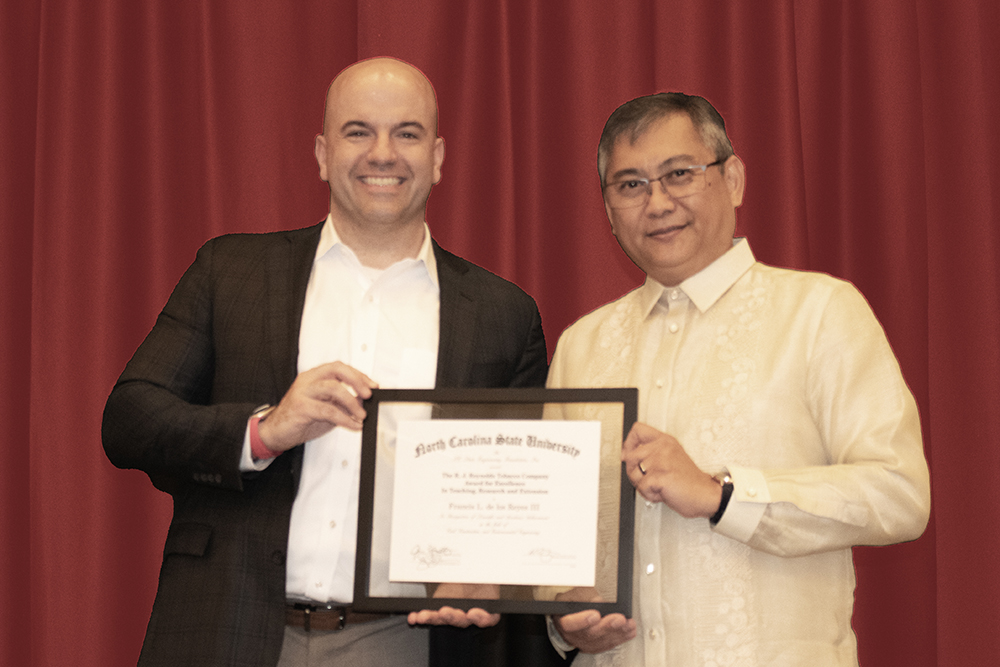Work by faculty members and students has made a difference for healthcare workers

On a Thursday morning in late May, the machine shop on the ground floor of Engineering Building III on NC State’s Centennial Campus is quiet for the first time in a long time.
Soon after the COVID-19 crisis started in the United States in early spring, a team of NC State Engineering faculty members and students undertook an effort to quickly design and produce personal protective equipment (PPE) for frontline healthcare workers in local hospitals and doctor’s offices. Soon, a group of about a dozen graduate students were working 10 to 12 hours a day in the shop, part of the Department of Mechanical and Aerospace Engineering (MAE), as the crisis deepened and healthcare systems worried about a lack of PPE needed to keep their employees safe. In the Edward P. Fitts Department of Industrial and Systems Engineering (ISE), students manned 3D printers 24 hours a day to produce face shields.
As spring turns to summer, MAE has begun transitioning the work to a local company. The machine shop space is normally used for senior design projects, and there is hope that those projects will be able to begin soon for the 2020-21 academic year. Dr. Landon Grace, an assistant professor in MAE, and Dr. Ola Harrysson, Edward P. Fitts Distinguished Professor in ISE, have led the efforts in the two departments. The two will soon return to research and preparing for a planned resumption of on-campus instruction beginning in August, leaving behind a spring semester in which they and their students made a huge difference in the lives of people in their community.
“It’s certainly been a different challenge,” Grace said of quickly creating a manufacturing line. “It’s one of the reasons I went into academics, all of the challenges.”
The Next Problem to Solve
The ISE team in the department’s Center for Additive Manufacturing and Logistics (CAMAL) has produced 1,100 face shields and 1,300 “ear savers” (pieces that take the pressure of elastics attached to face masks off of a wearer’s ears). The pieces have gone to WakeMed, one of the Triangle area’s largest health systems, but also to some small medical offices.
Matt White, a graduate student in ISE from Gastonia, NC, has taken the lead in the effort, working to optimize the production.
“I think it was a good learning experience for him,” Harrysson said.
As the demand for PPE has slowed down, the additive machines in CAMAL are no longer running 24 hours a day, though if the need for making equipment continues some machines can be run for that purpose, even as research and teaching in the center comes back online around them, Harrysson said.
Grace gives all the credit for the work in MAE to the graduate students from his research team and others who have innovated and done the assembly line work to produce the PPE.
For Rishabh Guha, a third-year Ph.D. student in Grace’s research group, the work has given him “a sense of giving back to the community.
“As Ph.D. students, we normally work on things that are so far down the road, we never see the impact of it.”
The PPE work, Guha said, has been different.
The team has manufactured 16,000 plastic face shields that work with a Controlled Air Purifying Respirator (CAPR) system, which provides a wearer with protection from inhaling germs using safe air in an enclosed helmet. The four-piece product includes a plastic face shield (cut from plastic sheets using the department’s laser cutter), a plastic film that provides a seal under the chin and two clips to attach to a CAPR helmet.
To seal the film to the faceshield, the team developed a two-piece system made up of a kitchen griddle and a homemade hand-held sealer that is heated and used to fuse the two pieces together.
When the overseas vendor that was providing latex material for the film seal could no longer supply it, the team got in contact with Polyzen, an Apex-NC-based manufacturer. Polyzen has been able to support the film supply through in-house extrusion capabilities. In addition, Polyzen has secondary operations such as heat sealing, die cutting and packaging services to assist with the ramp and on-going production of PPE from the MAE team. This has been valuable to leverage a team with the manufacturing skillset and quality infrastructure to handle the anticipated volume and simultaneously meet critical quality needs.
Most of the sets have gone to North Carolina healthcare systems, but units have been shipped as far away as New York, Chicago and California.
The team has also produced other protective face shields and an intubation shield that offers protection form airborne particles for healthcare providers working to intubate a patient.
Grace has worked with colleagues from UNC-Chapel Hill on an emergency ventilator. Though the demand for ventilators has decreased as the crisis has worn on, Grace thinks that the team’s work on a PEEP valve that is part of the respirator design will be valuable later on. Their design, which has been made open source, allows for creation of the valve using parts available at a hardware store. The PEEP valve is a spring-loaded piece that maintains pressure on the lung as a patient using a ventilator breathes in and out.
Grace and Dr. Tim Horn, an assistant professor in MAE, also put together a network of local 3D printers to produce a visor component that is part of a facemask set up. Volunteers have printed hundreds of pieces using specs from the MAE team and dropped them off at EB III, where students have cleaned them and done a quality control check before sending the pieces to local healthcare systems.
“My students and I are always looking forward to the next problem to solve,” Grace said. “And that’s what we do as engineers.”
- Categories:


